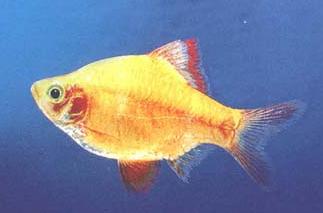Barb - Albino Tiger
Scientific Name: Barbus tetrazona
Sat, 12th July, 2025 - 4:00 am GMT
Sponsor Ads:

Alternative Name
Scientific Name: Barbus tetrazonaBasic Info
The Albino Tiger Barb is a relatively small fish. It will have about five white, slightly colored stripes. Albino Tiger Barbs will show the most coloration at their tips, with some reddish tints. It will only reach a size of two to three inches at maturity. Albino Tiger Barbs have alternating color and black vertical strips. Males, however, will have more of a redder than orange tint, especially in the nose and fin areas.
Health
Albino Tiger Barbs do not require any special attention and are rather hardy. They need their water to be between 68 and 78 degrees Fahrenheit. Albino Tiger Barbs do best in slightly acidic water, with a pH in the range of six to seven. They like to eat live and frozen food, such as: blood worms, glass worms, brine shrimp, plankton, daphnia and vegetables. They will eat flake and freeze dried foods, as well. Breeding Albino Tiger Barbs are egg layers. The coloring of the male becomes brighter during the spawning period and the female becomes larger.Habitat
Fresh water fishBehavior
Albino Tiger Barbs can add zest and life to any aquarium. This extremely active fish will keep an onlooker captivated for hours. They are especially pleasant when in schools of five or more. Albino Tiger Barbs are also hardy and easy to take care of, which makes them great for beginners, or a low maintenance tank. Don't let the name Albino Tiger Barb fool you. They are not a very aggressive fish. Tiger Barbs get their name from their body strips, which resemble those of a Tiger. They should be kept in schools. A lone Albino Tiger Barb will probably become overly aggressive towards its tank mates. Also, Albino Tiger Barbs might nip at other, less active fish, such as Angle Fish. Albino Tiger Barbs enjoy plenty of space, and decorations such as driftwood and rocks. They will not bother live plants.Origin
Southeast AsiaHistory
Tiger Barbs, or the Barbus tetrazona, are originally found in Borneo, Indonesia, Sumatra and Thailand. The Albino Tiger Barb is probably a man made hybrid, as no known Albinos have been found in the wild.Common Foods
N/ASponsor Ads:
"It is godlike ever to think on something beautiful and on something new." -- Democritus.
Barb - Albino Tiger
Coded by: BGID® | ALL RIGHTS RESERVED Copyright © 2000-2025
Disclaimer | Privacy | Report Errors / Contact | Credits


 President of the United States of America - Real Estate mogul, Pageant owner and now one of the most controversial men in political history.
President of the United States of America - Real Estate mogul, Pageant owner and now one of the most controversial men in political history.  Global warming has been in and out as the "latest" hot topic for many years. It is, according to modern scientists, the result of man-made industrial pollutants, clearing forested areas, agriculture, etc. But now they are thinking it started way before the Industrial Revolution...
Global warming has been in and out as the "latest" hot topic for many years. It is, according to modern scientists, the result of man-made industrial pollutants, clearing forested areas, agriculture, etc. But now they are thinking it started way before the Industrial Revolution...  Politician, US Vice President and President of the USA - Joseph Robinette Biden Jr.
Politician, US Vice President and President of the USA - Joseph Robinette Biden Jr.  versus
versus  Russia: 'The Evil Empire'? Are they all that bad or is it just the USA trying to portray Russia as bad because they are a world power with land bigger and a society very different from the USA ideal?
Russia: 'The Evil Empire'? Are they all that bad or is it just the USA trying to portray Russia as bad because they are a world power with land bigger and a society very different from the USA ideal? 
 Corona virus
Corona virus 
 Users with wide screen monitors can benefit from more content on every page.
Users with wide screen monitors can benefit from more content on every page.